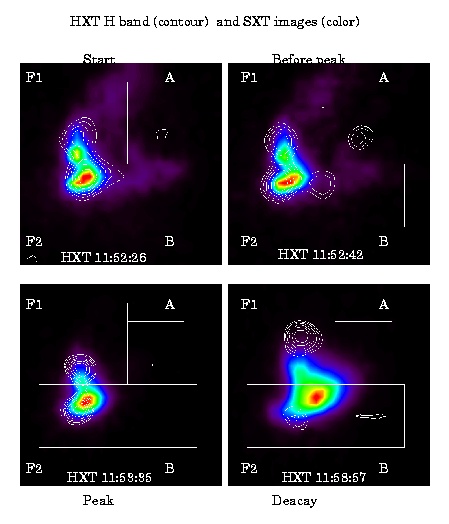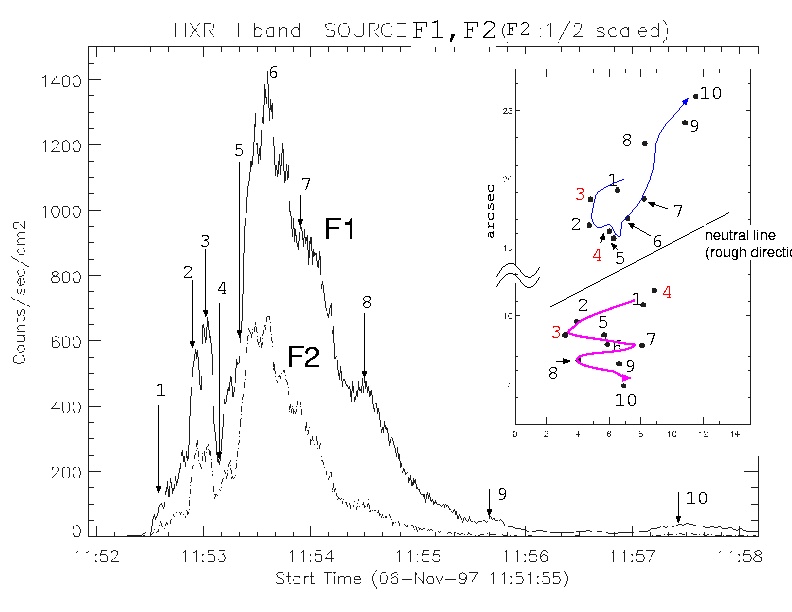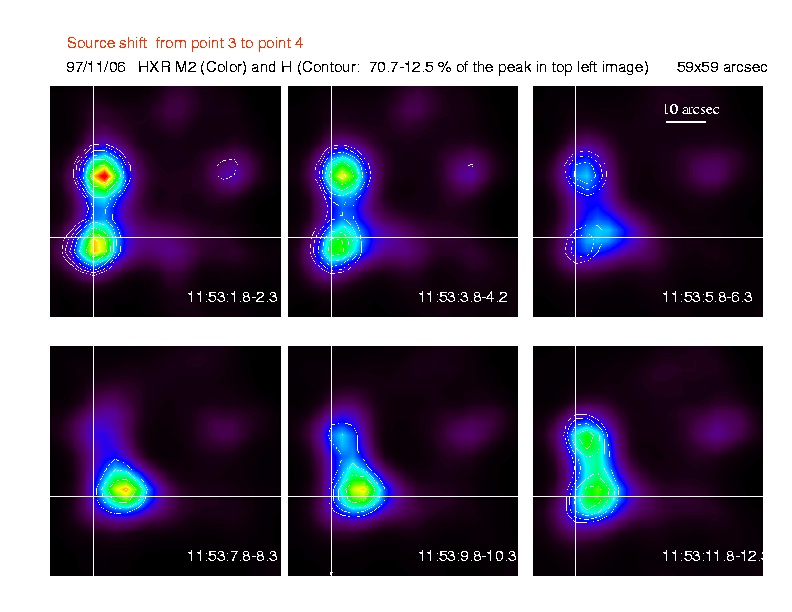
(Sato et al., Adv. Space Res., 26, 497 - 500, 2000.)
An intense flare, X9 in GOES class, occurred in AR 8100 at S16W62 on 6 November 1997. This yielded larger photon counts (in higher energy bands) than any other so far observed with HXT. The intense hard X-rays only lasted for a few minutes; this flare is a typical impulsive flare. We have synthesized images of this flare with a time resolution of 0.5 s over the four HXT energy bands (14-23-33-53-94 keV). The hard X-ray images, as a whole, reveal the presence of two intense sources, 10 to 20 arcsec apart from each other in the north-south direction, and in addition two relatively weak sources to the west of the intense ones, apparently seen in limited time intervals.

The two intense sources, hereafter called F1 (northern source) and F2 (southern source) respectively, seem to be footpoint sources located at the conjugate footpoints of a flaring loop (Sakao 1994). A brief comparison of the HXT images with a SOHO MDI magnetogram suggests that F1 and F2 are located in opposite magnetic polarities. It has been known that double footpoints are not necessarily stationary; they frequently show systematic motions, with either increasing or decreasing footpoint separation (Hoyng et al., 1981, Sakao et al., 1998). Since the footpoints are believed to represent the regions where energetic electrons stream down along magnetic field lines, the motions reflect shifts of electron injection site or energy release site in a solar flare, and hence may provide a crucial hint to understanding the coronal magnetic field structure and its change during a flare.

A result of our preliminary analysis is summarized in the figure shown above. As expected, F1 and F2 show similar time variations in flux to each other. The centroid positions of F1 and F2 at representative times, marked in the time profiles by vertical bars with numbers, are shown in the inset of this figure, which vividly reveals that both sources rapidly move at projected velocities of order 100 km/s. The motions of the two footpoint sources are complex; F1 first moves to the south-east direction, slightly approaching the magnetic neutral line, but turns around toward the north-west direction near the intensity peak, while F2 shows a more complicated motion, moving back and forth in the east-west direction, eventually separating from the neutral line. It is interesting, however, that the two motions are in some sense synchronous to each other. During the rising stage in hard X-ray intensity, the two sources move in the vicinity of the neutral line (from point 1 to point 5), and the separation between them does not increase so much. On the contrary, the two sources move systematically during the declining stage (from point 7 to point 10), and the separation increases monotonically. Superposed upon such systematic motions, we see abrupt shifts or jumps of source position; a most typical example is seen in the locus of F2 from point 3 to point 4. This jump is much larger than the measurement error, which is less than 1 arcsec judging from the r.m.s. scatter of 0.5-s data points (shown in the following figure ).

As clearly seen from this event, the hard X-ray footpoint motion can be measured with HXT with an accuracy of better than 1 arcsec, given enough hard X-ray photon counts. In the case of the 6 November 1997 flare, the double footpoint sources show complex but systematic motions. It suggests that the flaring magnetic field structure is complex, and that the energy release or particle acceleration site shifts in a systematic way. Since hard X-ray intensity is directly related to the number of energetic electrons that precipitate towards the footpoints, we anticipate that some quantitative analysis of energy release will be made available in conjunction with the coronal magnetic field structure. Towards this goal, the study is in progress.